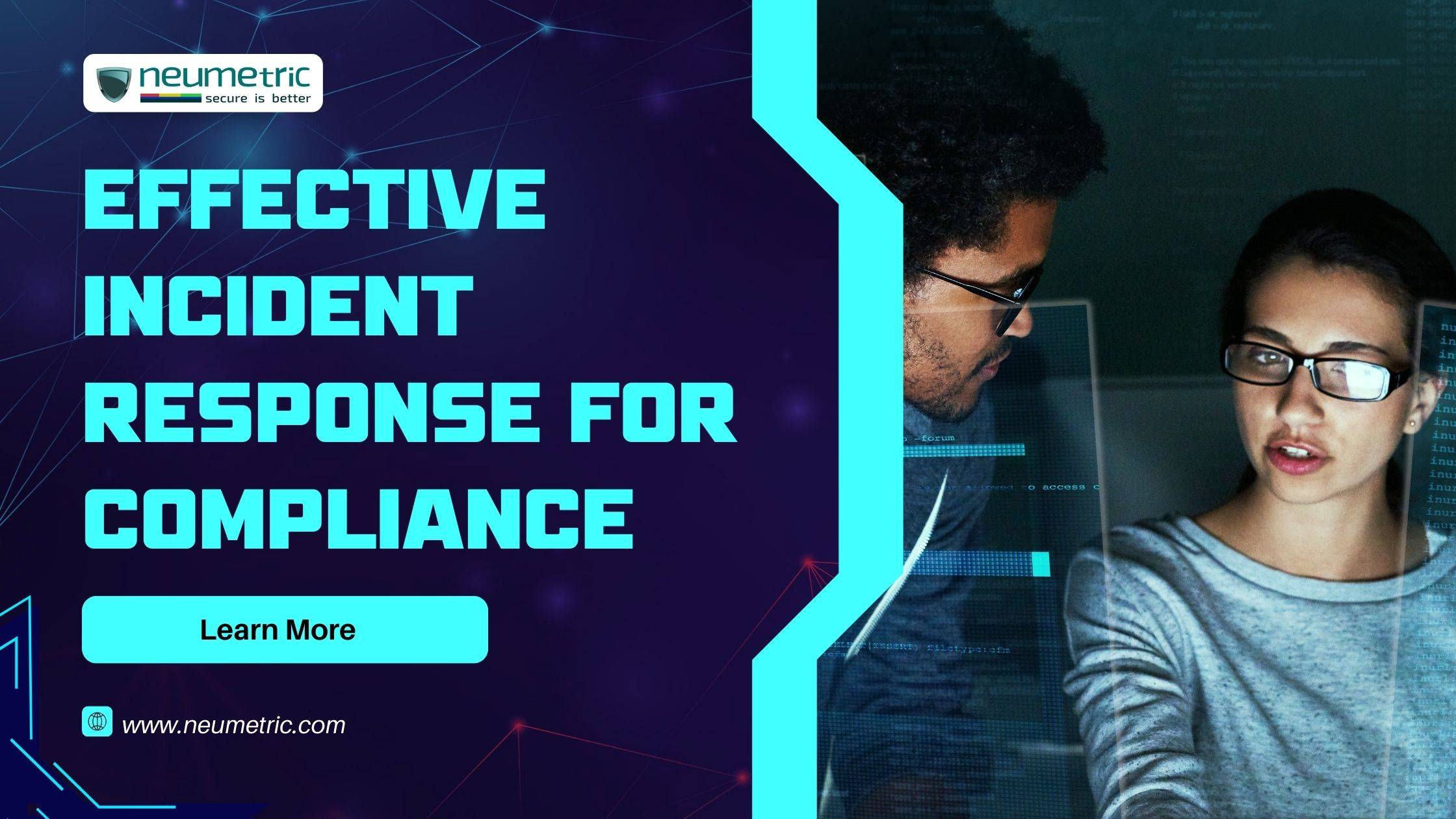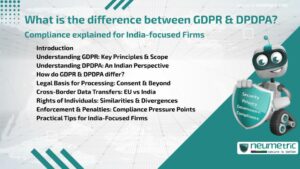Table of Contents
ToggleIntroduction
In the realms of cybersecurity & risk management, incident response & compliance are two key components. Incident response refers to organisations’ methodical approach to managing & mitigating the impact of security occurrences, whereas compliance entails adherence to industry norms, legal standards & internal policies. Incident response must be integrated into compliance policies for organisations that want to protect sensitive data, maintain operational integrity & fulfil regulatory requirements.
Effective incident response cannot be overstated in terms of preserving compliance. Security incidents, such as data breaches or cyberattacks, can result in noncompliance with different standards, with serious legal & financial ramifications. An effective incident response plan acts as a proactive tool for quickly identifying, containing, eliminating & recovering from security incidents. Organisations can limit the effect of incidents while simultaneously demonstrating due diligence to regulatory authorities & stakeholders by aligning incident response with compliance objectives. This alignment guarantees that the organisation is not only robust in the face of threats, but also that it is complying with the legal & industry-specific criteria that govern its operations.
Understanding Incident Response in Compliance
The methodical strategy to planning for, responding to & learning from security occurrences is referred to as incident response. Its fundamental principles are timely identification, effective containment, threat eradication, system recovery & post-incident analysis to prevent future occurrences. Understanding these concepts is essential for creating a complete incident response plan that is in line with compliance objectives.
The connection between incident response & regulatory compliance is mutual. As part of overall risk management, regulatory standards frequently require the establishment of robust incident response processes. Incident response strategies ensure that organisations notice & respond to security problems as soon as possible, minimising the impact on compliance. Compliance, in turn, necessitates that organizations have effective incident response measures in place to protect sensitive information, maintain the integrity of operations & fulfill regulatory obligations. The integration of incident response into compliance frameworks creates a cohesive strategy for safeguarding organizational assets & meeting regulatory expectations.
Key Components of an Effective Incident Response Plan
A. Preparedness
Risk Assessment & Compliance Requirements: The basis of incident response preparedness is a thorough risk assessment. Identifying possible threats, vulnerabilities & the impact of security incidents on compliance is part of this process. By aligning the incident response plan with compliance requirements, the organisation ensures that it addresses specific regulatory standards, legal obligations & industry best practices.
Building a Comprehensive Incident Response Team: Putting together a well-rounded incident response team is critical. Individuals with experience in cybersecurity, legal, communications & key business operations are included. Training team members on compliance subtleties creates a shared understanding of regulatory duties & allows for a more effective incident response.
B. Detection
Proactive Compliance Monitoring: Using proactive monitoring technologies & processes to discover potential compliance infractions in real time. Continuous monitoring enables organisations to quickly identify deviations from set compliance requirements, allowing for quick action to limit risks.
Using Technology for Early Detection: Using modern technologies such as intrusion detection systems, log analysis tools & Security Information & Event Management [SIEM] solutions to detect threats as they occur. Early detection is aided by technology, which provides insights into anomalous activity, potential dangers & departures from compliance norms.
C. Response
Immediate Mitigation Steps: Establishing immediate response measures to mitigate the effect of security issues. Predefined reaction actions provide a swift & coordinated attempt to control & neutralise threats while taking compliance implications into account.
Ensure Compliance Throughout Incident Resolution: Including compliance considerations in the response process to ensure that actions made are in accordance with regulatory requirements. All steps done during incident resolution should be documented to assist post-event reporting & compliance audits.
D. Recovery
Post-Incident Evaluation & Documentation: Conducting a thorough post-incident investigation to determine the core causes & their implications for compliance. Documentation is essential for regulatory reporting & internal analysis, as well as for facilitating continuous improvement.
Implementing Corrective Actions to Improve Future Compliance: Using incident findings to implement corrective measures & improve overall compliance. Continuous improvement guarantees that the incident response strategy adapts to new threats & changing compliance environments.
Challenges in Incident Response for Compliance
Adapting Incident Response to New Threats: The dynamic nature of the threat landscape makes maintaining compliance an ongoing issue for incident response. As new cyber threats develop, incident response strategies must evolve to address hostile actors’ shifting tactics, techniques & processes. This agility is critical for efficiently combating emerging threats & avoiding compliance violations.
Aligning Incident Response with Changing Compliance Standards: Compliance standards do not remain static; they adapt in reaction to changes in the cybersecurity landscape & regulatory environment. It is a constant struggle to ensure that incident response strategies correspond with these shifting requirements. Incident response teams must stay current on compliance requirements, modifying their methods & procedures to meet the most recent regulatory demands.
Balancing Incident Response Transparency with Privacy Compliance: Transparency, communication & disclosure to multiple stakeholders are frequently involved in incident response. Organisations, however, have the problem of reconciling transparency with compliance needs in the context of data privacy legislation. The complex issue of striking the correct balance between informing impacted parties & adhering to privacy requirements necessitates a nuanced approach in incident response preparation.
Navigating Cross-Border Data Protection Regulations: Many organizations operate in a global landscape, making cross-border data protection regulations a significant challenge. Incident response teams must navigate diverse legal frameworks governing data protection & privacy, especially when incidents involve the exposure of sensitive information across different jurisdictions. Navigating these regulations demands a comprehensive understanding of international laws to ensure compliance while responding effectively to incidents.
Technology’s Role in Enhancing Incident Response for Compliance
The incorporation of automation & Artificial Intelligence [AI] into incident response systems provides substantial benefits. Automated technologies can analyse large datasets quickly, discover trends that indicate possible issues & respond in real time. AI improves the efficiency of incident detection & response, resulting in timely actions that meet compliance requirements.
The difficulty is to seamlessly integrate compliance measures into incident response technology. This includes making certain that automated procedures adhere to compliance requirements & regulations. Automated incident detection technologies, for example, should be designed to recognise & respond to incidents in accordance with regulatory requirements. This integration improves the overall effectiveness of incident response while adhering to relevant standards.
In order to navigate these issues, organisations must take a proactive approach, frequently updating incident response plans, remaining updated about increasing compliance rules & appropriately leveraging technological innovations. In the face of a continually shifting threat landscape & regulatory environment, the synergy between effective incident response & compliance is critical in developing a resilient cybersecurity posture.
Regulatory Landscape Impacting Incident Response
Understanding the regulatory landscape is critical for incident response teams because compliance standards impact how security incidents are handled. GDPR [General Data Protection Regulation], HIPAA [Health Insurance Portability & Accountability Act] & PCI DSS [Payment Card Industry Data Security Standard] all have unique incident response requirements. For example, GDPR requires immediate notification of data breaches, emphasising transparency & accountability. To guarantee compliance, incident response plans must be aligned with these criteria.
Because of the particular nature of their operations, several sectors may have industry-specific compliance requirements. For example, the healthcare industry must follow rules such as HIPAA, whereas financial companies must follow regulations such as GLBA [Gramm-Leach-Bliley Act]. These specific compliance standards must be addressed in incident response strategies. By adapting incident response to industry standards, organisations ensure that they not only meet generic regulatory expectations but also handle subtleties specific to their industry.
Building a Culture of Continuous Improvement
Incorporating Incident Response Learnings into Compliance Programs
Incident response should be viewed as a continual cycle of improvement rather than a one-time activity. Each incident’s lessons should be methodically incorporated into compliance programmes. This includes analysing event root causes, finding areas for improvement & revising incident response strategies & compliance procedures as needed. Organisations build a culture of continuous improvement by incorporating incident response insights into compliance programmes.
Regular Training & Drills to Enhance Incident Response Preparedness
Organisations must engage in continual training & simulation exercises to ensure an efficient incident response. Regular drills incorporating event scenarios assist teams in refining their response capabilities, testing the efficacy of existing plans & identifying areas for development. This proactive approach improves not only incident response readiness but also the organization’s overall compliance stance.
Future Trends in Incident Response & Compliance
The future of incident response will most likely see technological breakthroughs that improve detection, response & recovery capabilities. Artificial Intelligence [AI] & automation are expected to play a larger role, allowing for faster & more accurate incident detection & response. In order to preserve compliance, these technology innovations must be carefully incorporated into incident response plans.
In response to new cyber risks & shifting business landscapes, regulatory requirements for incident response are projected to evolve. It will be critical to anticipate these developments & be proactive in aligning incident response with increasing regulatory expectations. Organisations must stay up to date on regulatory changes, participate in relevant industry forums & shape regulatory frameworks when possible.
Navigating the intersection of incident response & compliance requires a comprehensive understanding of regulatory standards, industry-specific requirements & a commitment to continuous improvement. By adapting incident response plans to comply with existing standards, tailoring them to industry specifics, integrating learnings into compliance programs & preparing for future trends, organizations can build a resilient framework that not only responds effectively to incidents but also meets & exceeds regulatory expectations.
Best Practices for Effective Incident Response & Compliance
Proactive Strategies for Incident Prevention
Effective incident response & compliance are built on prevention. Proactive tactics entail putting in place strong cybersecurity safeguards to avoid incidents before they happen. This includes doing frequent security assessments, managing vulnerabilities & establishing security measures to prevent potential threats. Organisations can considerably reduce the chance of security incidents that may effect compliance by detecting & resolving vulnerabilities in advance.
Continuous Monitoring & Assessment for Ongoing Compliance
Continuous monitoring is required to ensure compliance & effective incident response. This entails monitoring networks, systems & data in real time for anomalies or potential security incidents. Regular compliance control reviews ensure that the organization’s security procedures are in line with changing regulatory standards. Continuous monitoring & evaluation take a proactive approach, allowing organisations to discover & manage compliance concerns as they arise, reducing the impact of prospective events.
Conclusion
Finally, effective incident response & compliance are inextricably linked components of a holistic cybersecurity plan. A strong security posture is built on key principles including proactive incident prevention & constant monitoring. Proactive tactics not only prevent incidents, but also help to maintain compliance by addressing possible risks before they become major issues. Continuous monitoring ensures that organisations remain vigilant in the face of changing threats & comply with changing compliance standards.
The interdependence of incident response & compliance emphasises the importance of a comprehensive approach to cybersecurity. A security incident can have serious consequences for compliance, hence incident response must be smoothly integrated into compliance programmes. Lessons learned from incident reactions should be used to inform continuing compliance activities, establishing a feedback loop that improves the organization’s overall resilience.
The described best practices—proactive incident prevention, continuous monitoring & integrating incident response & compliance—lay the framework for a strong cybersecurity posture. Organisations that implement these practices not only improve their ability to prevent & respond to crises, but they also maintain continued compliance with regulatory standards, promoting a secure & resilient operational environment.
FAQ’s
- What is incident response in cybersecurity?
Incident response in cybersecurity refers to the systematic approach of preparing for, responding to & learning from security incidents, aiming to minimize damage & reduce recovery time & costs.
- How does continuous monitoring contribute to compliance?
Continuous monitoring helps organizations stay vigilant by actively observing networks & systems in real-time, ensuring ongoing compliance by promptly identifying & addressing potential security & regulatory issues.
- What are proactive strategies for incident prevention?
Proactive strategies for incident prevention include regular security assessments, vulnerability management & the implementation of security controls to identify & mitigate potential risks before they result in security incidents.





